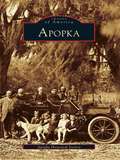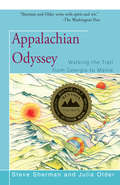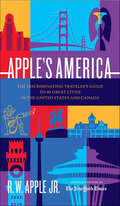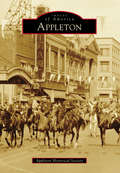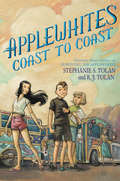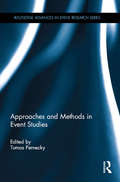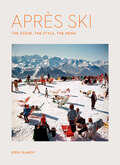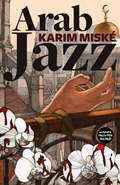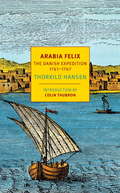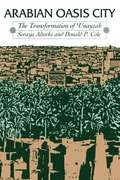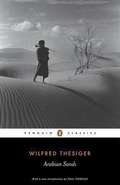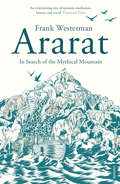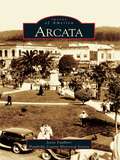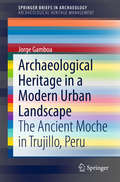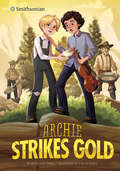- Table View
- List View
Apollo 11 Q&A: 175+ Fascinating Facts for Kids (History Q&A)
by Kelly Milner Halls175+ fascinating facts that teach kids ages 8 to 12 how we got to the moon From cube-shaped astronaut foods to the famous moon walk, there are so many incredible things for kids to learn about the Apollo 11 mission. This engaging guide introduces kids to the legacy of Apollo 11 through short, fun Q&As. They'll see how awesome learning can be as they read about spaceships, astronauts, space suits, and more—one easy-to-understand answer at a time. Go beyond other Apollo 11 books for kids with: New ways to learn—Launch kids into the history of the Apollo 11 mission with Q&As, true or false questions, and fun facts. Shareable history—This book is packed full of bite-sized bits of history that are both memorable and exciting for kids to tell their friends and family. A complete overview—From the start of the space race to the ways the Apollo 11 mission still affects modern space travel, kids will get a comprehensive look at America's space program. Spark a lifelong love of history in young astronauts with this top choice in space books for kids.
Apollo 11: The Eagle Has Landed
by Leigh AndersonHave you ever looked into the night sky and wished that you could walk on the Moon? Find about what it is like from the astronauts that were first to do it! Learn about how Neil Armstrong, Edwin Aldrin, and Michael Collins traveled into space and created history in 1969, and what it was like to take those famous first steps that made “one giant leap for mankind."
Apologies to My Censor
by Mitch MoxleyThe story of a young mans outrageous adventures in China and his search for identity in the most unexpected of places. Mitch Moxley came to Beijing in the spring of 2007 to take a job as a writer and editor for China Daily, the countrys only English-language national newspaper. The Chinese economy was booming, the Olympics were on the horizon, and Beijing was being transformed into a world-class city overnight. Moxley planned to stay only through the Olympics and then head back to Canada. But that was six years ago. In that time, Moxley fed a goat to a lion, watched a lingerie-wearing bear ride a bicycle, and crisscrossed the country writing stories. He also appeared as one of Cosmopolitans one hundred most eligible bachelors in China, acted in a state-funded Chinese movie, and was paid to pose as a fake businessman. During Moxleys journey of self-exploration, his comic adventures and misadventures in China gave way to the creation of his alter ego--Mi Gao, or Tall Rice. A funny and honest look at expat life, Apologies to My Censor also depicts the ways a country can touch and inspire you.
Apopka
by Apopka Historical SocietyApopka, Florida, started out as a place once dubbed "Big Potato" by the Native Americans of the area and was formerly known as the "Fern City," but it is now most notably considered the "Indoor Foliage Capitol of the World." Once-thriving fragrant citrus groves have been replaced by climate-controlled greenhouses and fields of landscaped nurseries and subdivisions. The second largest city in Orange County, Apopka is located in the northwest region of the county. It functions today as a bedroom community for Orlando and boasts the history of a community filled with a deep sense of pride.
Apostle
by Tom BissellA profound and moving journey into the heart of Christianity that explores the mysterious and often paradoxical lives and legacies of the Twelve Apostles--a book both for those of the faith and for others who seek to understand Christianity from the outside in. Peter, Matthew, Thomas, John: Who were these men? What was their relationship to Jesus? Tom Bissell provides rich and surprising answers to these ancient, elusive questions. He examines not just who these men were (and weren't), but also how their identities have taken shape over the course of two millennia. Ultimately, Bissell finds that the story of the apostles is the story of early Christianity: its competing versions of Jesus's ministry, its countless schisms, and its ultimate evolution from an obscure Jewish sect to the global faith we know today in all its forms and permutations. In his quest to understand the underpinnings of the world's largest religion, Bissell embarks on a years-long pilgrimage to the supposed tombs of the Twelve Apostles. He travels from Jerusalem and Rome to Turkey, Greece, Spain, France, India, and Kyrgyzstan, vividly capturing the rich diversity of Christianity's worldwide reach. Along the way, he engages with a host of characters--priests, paupers, a Vatican archaeologist, a Palestinian taxi driver, a Russian monk--posing sharp questions that range from the religious to the philosophical to the political. Written with warmth, empathy, and rare acumen, Apostle is a brilliant synthesis of travel writing, biblical history, and a deep, lifelong relationship with Christianity. The result is an unusual, erudite, and at times hilarious book--a religious, intellectual, and personal adventure fit for believers, scholars, and wanderers alike.From the Hardcover edition.
Apostle: Travels Among the Tombs of the Twelve
by Tom BissellA profound and moving journey into the heart of Christianity that explores the mysterious and often paradoxical lives and legacies of the Twelve Apostles—a book both for those of the faith and for others who seek to understand Christianity from the outside in.“Expertly researched and fascinating… Bissell is a wonderfully sure guide to these mysterious men.… This is a serious book about the origins of Christianity that is also very funny. How often can you say that?” —The Independent Peter, Matthew, Thomas, John: Who were these men? What was their relationship to Jesus? Tom Bissell provides rich and surprising answers to these ancient, elusive questions. He examines not just who these men were (and weren’t), but also how their identities have taken shape over the course of two millennia. Ultimately, Bissell finds that the story of the apostles is the story of early Christianity: its competing versions of Jesus’s ministry, its countless schisms, and its ultimate evolution from an obscure Jewish sect to the global faith we know today in all its forms and permutations. In his quest to understand the underpinnings of the world’s largest religion, Bissell embarks on a years-long pilgrimage to the supposed tombs of the Twelve Apostles. He travels from Jerusalem and Rome to Turkey, Greece, Spain, France, India, and Kyrgyzstan, vividly capturing the rich diversity of Christianity’s worldwide reach. Along the way, he engages with a host of characters—priests, paupers, a Vatican archaeologist, a Palestinian taxi driver, a Russian monk—posing sharp questions that range from the religious to the philosophical to the political. Written with warmth, empathy, and rare acumen, Apostle is a brilliant synthesis of travel writing, biblical history, and a deep, lifelong relationship with Christianity. The result is an unusual, erudite, and at times hilarious book—a religious, intellectual, and personal adventure fit for believers, scholars, and wanderers alike.From the Hardcover edition.
Appalachian Odyssey: Walking the Trail from Georgia to Maine
by Julia Older Steve ShermanTrail along on this 2,000-mile, bliss-and-blister adventure away from interstates and into backwoods America. Cross the Smokies, survive Virginia floods, buck New Jersey heat, walk the Presidentials of the White Mountains, and traverse a mile-long gorge. Then, 150 days later, stand victorious on the summit of Mount Katahdin in Maine. Appalachian Odyssey has everything--and then some--about the great hike. Inspiring for all ages whether you're a backpacker or an armchair hiker. Appalachian Odyssey was awarded the Honorable Mention in the Outdoor Classic category by the 2009 National Outdoor Book Awards (NOBA). The Outdoor Classic Award is presented annually to an "unusual and lasting" book that over time has proven to be a significant work in the field.
Appetite for Power: Eating, Drinking & Dealmaking in NYC: A Billions Guide
by Bahar LeventogluMore than One Hundred Iconic New York City Dining Institutions From hole-in-the-walls to cozy neighborhood gems to Michelin-starred restaurants, the characters in the SHOWTIME® series Billions know how to eat well, as any fan of the beloved show can confirm. Creators Brian Koppelman and David Levien spectacularly display the city's vibrant food scene—but it's more than showing us how the one percent eats. It's about integrating food, which brings people together and is an integral part of our daily lives, into the storyline while honoring the quality, the diversity, and the legacy of culinary culture in New York City. It&’s about the city staples that have been around for generations. It&’s about the immigrants who brought their own food to New York and made it a part of city culture. It&’s about the power joints where the movers and shakers of the city discuss the affairs of the day. It&’s about the pizza slice or the candy bar that takes you back to your childhood. It&’s about those who start at the bottom of the kitchen chain and ultimately open their own restaurant as well as about the old who pass the torch to future generations. It&’s about the energy and the creativity in New York food industry that is setting the standards for the rest of the world. It&’s about everyone who has contributed to making New York the dining capital of the world as it is today. This book presents the complete list of restaurants, bars, bakeries, bodegas, and more, featured in Billions. The listings include description and history of the chef and building, signature dishes, fun facts, and of course, tie-in to the show's storyline. Which characters are eating there? What is the occasion? What are they discussing? Features include: Empire DinerYonah Schimmel&’s Knish BakerySushi NakazawaPeking Duck HouseVeselkaThe Spotted PigIvan RamenLibrary Bar at the NoMad HotelEmmy SquaredMorgenstern's Ice CreamSo many more!
Apple Of My Eye
by Hélène HanffA celebration of her life-long love for New York, Hanff embarked on this project as an assignment, and realized she had not been to many of the main tourist attractions- the Statue of Liberty, Wall Street, the World Trade Center. <P><P>As make-believe tourists, off she and Patsy travel to describe the Metropolitan Museum of Art, Grant's Tomb, Fraunces Tavern, some of New York's very special small museums, Orchard Street, a tour of Harlem, and much more. <P><P>Hanff weaves in historical events and tidbits on some of New York's most notorious personalities.
Apple's America: The Discriminating Traveler's Guide to 40 Great Cities in the United States and Canada
by R. W. Apple Jr.Unpretentious, sophisticated, and always appetizing advice from a celebrated authorityFor more than thirty years, R. W. Apple Jr. roamed the United States as an eyewitness to history. Here, in Apple's America, his robust enthusiasm for the food and culture of New England, the South and West, the Atlantic and Pacific coasts, and his native Middle West carried him to forty great cities, where he proves to be our ideal guide--amused and amusing, knowledgeable, indefatigable, and endlessly curious.From Boston to Honolulu, from Montreal to Las Vegas, Cincinnati to Seattle, Johnny Apple explores the landmarks, architecture, business, culture, and, of course, the food and beverages of his favorite urban communities. Capturing the tone and style of American city life to perfection, he shows us the hidden treasures, the best buildings, the famous landmarks, the historical aura, and the present-day realities that make each city so memorable. And in each he recommends several places to stay, numerous places to eat, and sites or activities you shouldn't miss. No traveler in the United States will want to do without his recommendations.
Appleton
by Appleton Historical SocietyAppleton's rich beginnings found their source at Lawrence Institute, the university in the woods, on the Fox River. Rev. Henry Colman and Rev. William Sampson chose the bluff on the river for the site of the institute. Amos A. Lawrence donated $10,000, and the building began in July 1848. It was with axe and hook that the first settlers cleared the land for Lawrence and Appleton. The city was made up of three villages: Martin (Grand Chute), Appleton, and Lawesburg. In 1857, the villages joined together to form the city of Appleton. Amos Story was the city's first mayor. Appleton's industry grew on the banks of the Fox River, including hydroelectricity and paper.
Applewhites Coast to Coast
by Stephanie S. Tolan R. J. TolanThis third story about the madcap family introduced in Stephanie Tolan’s Newbery Honor Book Surviving the Applewhites features even more outlandish adventures and will appeal to fans of the Applewhites and those meeting them for the first time.E.D. and Jake are doing their best to forget their bewildering kiss—after all, they’re practically family—and get back to “normal” life with the decidedly abnormal, highly creative Applewhites.When the family’s biggest fan, Jeremy Bernstein, pulls up to Wit’s End in an “Art Bus,” he brings with him a proposal for an Education Expedition: a cross-country road trip, educational quest, and video-documented competition for a big cash prize. Jeremy also drags along his troubled but beautiful niece, Melody. She’ll be joining the expedition with her own rebellious flair, much to Jake’s delight . . . and E.D.’s exasperation.With characteristic Applewhite enthusiasm, the artists face disastrous performances, fainting goats, and some very bad ideas—but can they make it through the road trip in one piece?
Approaches and Methods in Event Studies (Routledge Advances in Event Research Series)
by Tomas PerneckyThe recent proliferation of events as a subject of study in its own right has signalled the emergence of a new field – event studies. However, whilst the management-inspired notion of planned events, which strives for conceptual slenderness, may indeed be useful for event managers, the moment we attempt to advance knowledge about events as social, cultural and political phenomena, we realise the extent to which the field is theoretically impoverished. Event studies, it is argued, must transcend overt business-like perspectives in order to grasp events in their complexities. This book challenges the reader to reach beyond the established modes of thinking about events by placing them against a backdrop of much wider, critical discourse. Approaches and Methods in Event Studies emerges as a conceptual and methodological tour de force—comprising the works of scholars of diverse backgrounds coming together to address a range of philosophical, theoretical, and methods-related problems. The areas covered include the concepts of eventification and eventual approaches to events, a mobilities paradigm, rhizomatic events, critical discourse analysis, visual methods, reflexive and ethnographic research into events, and indigenous acumen. Researchers and students engaged in the study of events will draw much inspiration from the contributions and from the volume as a whole.
Après Ski: The Scene, the Style, the Menu
by Erin IsakovA celebration of the skiing lifestyle on and off the slopes, in a gorgeous must-have package—including dazzling stained edges! Skiing is more than just a sport. It's a lifestyle. A way of life. Après-ski typically refers to the time of day right after skiing, but can extend into the evening and early morning hours. It's cocktails enjoyed at the famed Palace Hotel ice rink bar in St. Moritz, and a game of snow polo in Aspen; a dip in the Manza Onsen (one of Japan&’s highest-altitude hot springs) and dancing on tables at La Folie Douce in Val d&’Isère, France. Traditions vary by region and even by neighboring resort. No matter where or how you unwind after a day on the mountain, what happens around the actual skiing has helped shape the culture of the sport for decades. This book is a visual celebration of all things après-ski: the best spots to visit around the globe, a survey of the fashion and style of ski, and even food and drink recipes for the quintessential après–ski menu.
Arab Jazz
by Karim MiskéKosher sushi, kebabs, a second hand bookshop and a bar: the 19th arrondissement in Paris is a cosmopolitan neighbourhood where multicultural citizens live, love and worship alongside one another. This peace is shattered when Ahmed Taroudant's melancholy daydreams are interrupted by the blood dripping from his upstairs neighbour's brutally mutilated corpse. The violent murder of Laura Vignole, and the pork joint placed next to her, set imaginations ablaze across the neighborhood, and Ahmed finds himself the prime suspect. However detectives Rachel Kupferstein and Jean Hamelot are not short of leads. What is the connection between a disbanded hip-hop group and the fiery extremist preachers that jostle in the streets for attention? And what is the mysterious new pill that is taking the district by storm? In this his debut novel, Karim Miské demonstrates a masterful control of setting, as he moves seamlessly between the sensual streets of Paris and the synagogues of New York to reveal the truth behind a horrifying crime.
Arabia Felix: The Danish Expedition of 1761-1767
by Colin Thubron James Mcfarlane Kathleen Mcfarlane Thorkild HansenA riveting account of a landmark expedition that left only one survivor, now back in print for the first time in decades.Arabia Felix is the spellbinding true story of a scientific expedition gone disastrously awry. On a winter morning in 1761 six men leave Copenhagen by sea—a botanist, a philologist, an astronomer, a doctor, an artist, and their manservant—an ill-assorted band of men who dislike and distrust one another from the start. These are the members of the Danish expedition to Arabia Felix, as Yemen was then known, the first organized foray into a corner of the world unknown to Europeans. The expedition made its way to Turkey and Egypt, by which time its members were already actively seeking to undercut and even kill one another, before disappearing into the harsh desert that was their destination. Nearly seven years later a single survivor returned to Denmark to find himself forgotten and all the specimens that had been sent back ruined by neglect. Based on diaries, notebooks, and sketches that lay unread in Danish archives until the twentieth century, Arabia Felix is a tale of intellectual rivalry and a comedy of very bad manners, as well as an utterly absorbing adventure.Arabia Felix includes 33 line drawings and maps.
Arabia: A Journey Through The Heart of the Middle East
by Levison WoodShortlisted for the 2019 Edward Stanford Award '[A] rollicking Boys' Own adventure' - Spectator'This heart-stopping personal account of historic Arabia today.' - Compass MagazineFollowing in the footsteps of Lawrence of Arabia and Wilfred Thesiger, Arabia is an insight into Levison Wood's most complex and daring expedition yet: an epic and unprecedented 5000-mile journey through 13 countries, circumnavigating the Arabian Peninsula.Honest, reflective and poignant, Arabia is a historical, religious and spiritual journey, through some of the harshest and most beautiful environments on Earth. Exploring the Middle East through the lives, hearts and hopes of its people, Levison Wood challenges the perceptions of an often misunderstood part of the world, seeing how the region has changed and examining the stories we don't often hear about in the media.
Arabia: A Journey Through The Heart of the Middle East
by Levison WoodThe award-winning TV adventurer and travel writer's enthralling account of his 5,000-mile expedition around the Arabian Peninsula, from Iraq to Lebanon.Following in the footsteps of great explorers such as Lawrence of Arabia and Wilfred Thesiger, Arabia is Levison Wood's account of his most complex expedition yet: circumnavigating the Arabian Peninsula. Travelling through some of the harshest and most beautiful environments on earth, he seeks to challenge our perceptions of an often misunderstood part of the world, seeing how the region has changed and examining the stories we don't often hear about in the media. (P)2018 Hodder & Stoughton Limited
Arabian Oasis City: The Transformation of Unayzah
by Soraya Altorki Donald P. ColeVast social change has occurred in the Middle East since the oil boom of the mid-1970s. As the first anthropological study of an urban community in Saudi Arabia since that oil boom, Arabian Oasis City is also the first to document those changes. Based on extensive interviews and participant observation with both men and women, the authors record and analyze the transformation that has occurred in this ancient oasis city throughout the twentieth century: the creation of the present Saudi Arabian state and of a new national economy based on the export of oil and the economic boom brought about by the dramatic increases in the price of oil following the October 1973 Arab-Israeli War. In addition, the authors reveal the changes brought about by the fall in the price of oil beginning in 1982 and analyze the problems confronting 'Unayzah in its aftermath. By demonstrating that the area was not exclusively dominated by tribalism and Bedouin nomads, this empirical case study destroys stereotypical views about Saudi Arabia. Indeed, it proves the existence-prior to the coming of the modern Saudi Arabian state-of surplus agricultural and craft production and the full development of local, regional, and long-distance trade networks. It shows that women, although veiled, played active roles in work outside the household. The social impact of change over the years is, however, profound-especially the gradual replacement of the extended family by the nuclear family, changing patterns of husband-wife relationships, the impact of self-earned income on the status of women, and the emergence of a new middle class of employees and entrepreneurs. Because of the high degree of gender segregation in this area of research, Altorki and Cole give us a fortunate collaboration between a Saudi Arabian female scholar and an American male scholar experienced in research in the Middle East. Both are professors of anthropology at the American University in Cairo.
Arabian Sands
by Rory Stewart Wilfred ThesigerIn Arabian Sands, William Thesiger charts the time he spent living with the Bedu, including his legendary traverses of the Empty Quarter.
Aramis (Or, The Love of Technology)
by Bruno Latour Catherine PorterBruno Latour has written a unique and wonderful tale of a technological dream gone wrong. As the young engineer and professor follow Aramis' trail--conducting interviews, analyzing documents, assessing the evidence--perspectives keep shifting: the truth is revealed as multilayered, unascertainable, comprising an array of possibilities worthy of Rashomon. The reader is eventually led to see the project from the point of view of Aramis, and along the way gains insight into the relationship between human beings and their technological creations. This charming and profound book, part novel and part sociological study, is Latour at his thought-provoking best.
Ararat: In Search of the Mythical Mountain
by Frank WestermanMount Ararat in Turkey is where, as biblical tradition has it, Noah's Ark ran aground and God made his covenant with mankind. Now it stands astride the fault-line between religion and science, a geographical, political and cultural crossroads, bound up with the centuries-old history of warfare between different cultures in this region. Frank Westerman takes a pilgrimage from the mountain's foot to its highest slopes, meeting along the way geologists, priests and an expedition in search of the Ark's remains, as well as a Russian astronaut who observes that 'there is something between heaven and earth about which we humans know nothing'. Ararat is a dazzling, highly personal book about science, religion and all that lies between, by one of Europe's most celebrated young writers.
Arcata (Images of America)
by Humboldt County Historical Society Jessie FaulknerArcata, a bright jewel surrounded by the redwood forested hills of northern Humboldt Bay, was once the territory of the Wiyot Indians. The tribe only barely survived massacres and relocation after a town was founded there in 1850, a supply point for gold seekers at nearby mines. That town soon evolved into a center for a thriving lumber industry that fed sawmills and a barrel factory, and dairies that prospered on the pastoral Arcata Bottom. Home to Humboldt State University and the much loved Humboldt Crabs baseball team, Arcata is attracting new businesses, industries, and national attention for its innovative Arcata Marsh public works project.
Archaeological Heritage in a Modern Urban Landscape: The Ancient Moche in Trujillo, Peru (SpringerBriefs in Archaeology #13)
by Jorge GamboaArchaeological Heritage in a Modern Urban Landscape evaluates issues about the preservation, social role and management of archaeological sites in the Trujillo area, north coast of Peru, specifically those of the Moche culture (100-800 AD). Moche was one of the great civilizations of ancient Peru, with spectacular ceremonial adobe architecture and settlements distributed across a landscape formed by coastal valleys and one of the largest deserts of South America. In the last decades political and economic changes have brought rural migrations to the city of Trujillo and nearby zones, causing the emergence of extensive new communities in the margins of the metropolis. And although Trujillo's Moche heritage has become a symbol of regional identity, most local Moche sites are under siege because of urban development. This book offers a new perspective on the development of modern communities settled beside archaeological sites and contributes to improving best practices in the management of archaeological sites and preservation in an urban setting.
Archie Strikes Gold (Smithsonian Historical Fiction)
by Brandon TerrellArchie is traveling with his uncle Harold, a member of an entertainment revue hired by the renovated Dawson City Theatre, to perform for the Yukon gold rushers. While there, Harold befriends an older gentleman, Montgomery Wycroft, who is in the area panning for gold. Archie and his uncle opt to stay behind in Dawson City, joining Monty on his dangerous quest for gold, battling with both greedy gold-seekers and the unforgiving Canadian terrain. Will Archie and his uncle strike gold, or will they find something more valuable?



